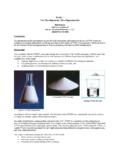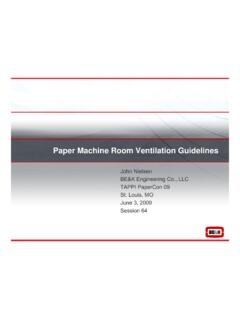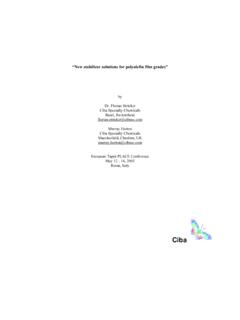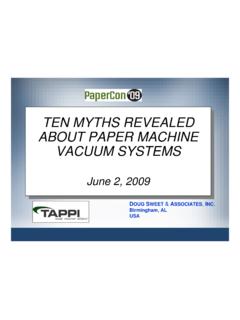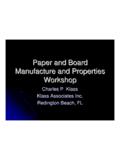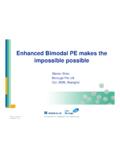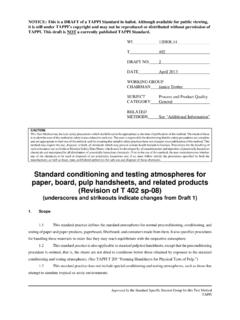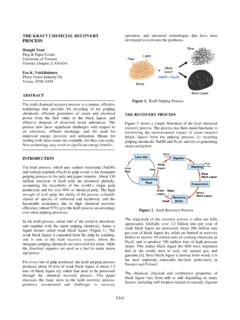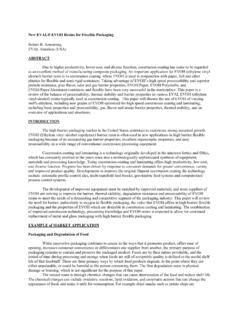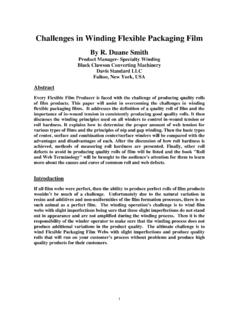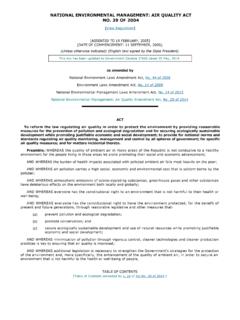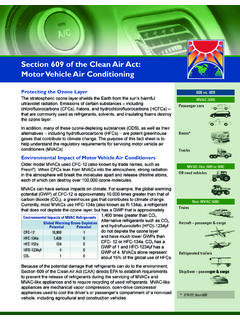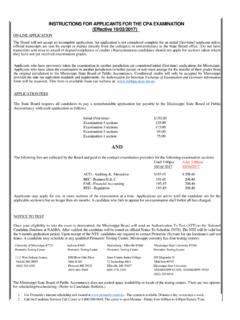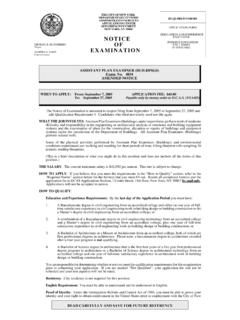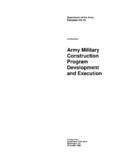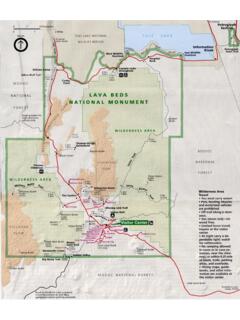Transcription of Basic density and moisture content of pulpwood ...
1 WI T 258 DRAFT NO. 2 DATE August 2, 2006 TAPPI WORKING GROUP CHAIRMAN N/A; method reaffirmed SUBJECT CATEGORY Pulp Properties RELATED METHODS See Additional Information Approved by the Standard Specific Interest Group for this Test Method TAPPI CAUTION: This Test Method may include safety precautions which are believed to be appropriate at the time of publication of the method.
2 The intent of these is to alert the user of the method to safety issues related to such use. The user is responsible for determining that the safety precautions are complete and are appropriate to their use of the method, and for ensuring that suitable safety practices have not changed since publication of the method. This method may require the use, disposal, or both, of chemicals which may present serious health hazards to humans. Procedures for the handling of such substances are set forth on Material Safety Data Sheets which must be developed by all manufacturers and importers of potentially hazardous chemicals and maintained by all distributors of potentially hazardous chemicals. Prior to the use of this method, the user must determine whether any of the chemicals to be used or disposed of are potentially hazardous and, if so, must follow strictly the procedures specified by both the manufacturer, as well as local, state, and federal authorities for safe use and disposal of these chemicals.
3 Basic density and moisture content of pulpwood (Reaffirmation of T 258 om-02) (no text changes from Draft 1) 1. Scope and summary This method describes the measurement of the Basic density (bone-dry weight per unit of maximum volume) of pulpwood in the form of chips or disks from the cross section of logs. The method also gives procedures for determining the moisture content of wood in either form. For moisture content of wood in the form of sawdust see TAPPI T 264 Preparation of Wood for Chemical Analysis (Including Procedures for Removal of Extractives and Determination of moisture content ). moisture content is determined by the difference in weight as received and after drying at 105 3 C. Volume is determined by the amount of water displaced by the test specimen of wood.
4 Because wood swells or shrinks, respectively, with absorption or loss of water, it is necessary to express the density at a specified moisture content and corresponding volume. The usual conditions are the minimum (oven-dry T 258 om-02 Basic density and moisture content of pulpwood / 2 or moisture -free) weight and the maximum (green) or the minimum (oven-dry or moisture -free) volume. For most purposes, the maximum volume basis is sufficient. In the present method the specimen is considered to have swollen to its maximum volume when its moisture content exceeds the fiber-saturation point, which lies between 18 and 26% by weight (wet basis) for most species. Procedures for obtaining the volume, both green and oven-dry, are described in this method.
5 NOTE 1: Many wood technologists consider the density of wood is best expressed only on the basis of oven-dry weight and maximum volume, because at moisture contents above the fiber-saturation point the maximum volume is essentially constant. 2. Significance pulpwood , as logs or chips, is often purchased on a volume basis. It is also normally charged to the digester by volume. The moisture content and density of the wood are significant values for comparative pulpwood costs, for inventory control, and for proper processing such as digester load and alkali charge. 3. Definitions density is the ratio of the mass of a quantity of a substance to its volume and is expressed in terms of weight per unit volume. The density of the wood portion of pulpwood and chips may be expressed as: As-received density , obtained by dividing the as-received weight by the as-received volume.
6 Green density , obtained by dividing the green (maximum swollen) weight by the green (maximum swollen) volume. Basic density , obtained by dividing the oven-dry weight by the green (maximum swollen) volume. Oven-dry density , obtained by dividing the oven-dry weight by the oven-dry volume. Bulk density , obtained by dividing the weight (at specified conditions) of the specimen (chips) by the bulk volume at the conditions indicated. It can be expressed in the same terms as Basic density (see TAPPI UM 23 Bulk density of Wood Chips ). NOTE 2: At initial moisture contents above the fiber saturation concentration (18-26% moisture ), as-received and green densities will be identical. 3 / Basic density and moisture content of pulp wood T 258 om-02 TEST PROCEDURES FOR DISKS 4.
7 Apparatus Balance, capacity 1 kg, sensitivity g. Balance, minimum capacity 500 g, sensitivity g. This balance has a weighted hook substituting for the left balance pan and hanger, and so mounted on a support that the hook will be suspended above an open 114-L (30-gal) container (see Fig. 1). Electronic balances such as Ohaus GT series, or equivalent, equipped with a hanger to permit below-the-balance weighting are also suitable when mounted in an appropriate manner above the 114-L container. The weighted hook should be exactly the weight of the pan and hanger which has been replaced or sufficiently close to the same weight so that it can be counterbalanced by the adjusting screws. Fig. 1. Apparatus for suspended submergences method for volume determination of disks.
8 Container, for holding water for submerging disks. A 114-L (30-gal) galvanized or plastic trash container is satisfactory for the purpose. Holding clamp. This clamp, such as a 200-A battery clamp, should be attached to a fine wire or thread, which, in turn, is attached to an eye for hanging the clamp from the weighted hook on the balance. The wire or thread must be long enough that the clamp and the eye to which the wire is attached are completely submerged in the water held in the container. Submerging plummets (3 or 4), in the range of 50 to 500 g (as for example 50, 100, 200 and 500 g). Each of these plummets must be attached to a clamp (200-A battery clamps are suitable). Drying oven, forced air, constant temperature 105 3 C, with drying rack of wire, so constructed that the disks can be placed on edge in the oven, and several thus held without touching one another.
9 T 258 om-02 Basic density and moisture content of pulpwood / 4 Saw, circular or chain. 5. Materials Paraffin wax, commercial grade. 6. Sampling Select a number of sample logs according to TAPPI T 257 Sampling and Preparing Wood for Analysis. 7. Test specimens From each sample log, with a sharp saw, cut a specimen disk of solid wood 20-25 mm (3/4-1 in.) thick from an undamaged, sound, and knot-free section. Preferably cut the disks from the center or at least 300 mm (at least 12 in.) from the end of each log so as to avoid end checks. Quickly remove any bark, adhering splinters, and sawdust from each disk. Reduce the size of any disks too large for the available vessel used for obtaining the submerged weight by cutting a wedge or half disk section and mark the pieces for identification.
10 NOTE 3: The volume of the specimen required is the outside boundary, exclusive of surface depressions; therefore, cleanly cut the disks. Place the specimen disks in a covered container as soon as cut to prevent loss of moisture . 8. Procedures moisture content . Determine the moisture content from the as-received weight and the oven-dry (or moisture -free) weight. If the moisture content alone is desired, it is necessary only to determine the as-received weight as described in Section and then immediately proceed to the measurement of oven-dry weight in Section As-received weight of disks. Brush off sawdust and dirt from surfaces of disk and weigh disk promptly. If the disk is too large in diameter to be weighed readily, cut it into pie-shaped segments, weigh each segment and total the weights of the segments.
